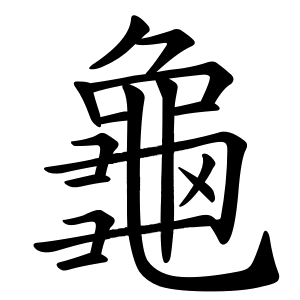龜
- tortoise, turtle;
- to crack, to split;
- place name;
Etymology
龜 is a pictograph, modeled directly after the shape of a turtle.
In oracle bone script and bronze inscriptions, it clearly depicts the full turtle form.
In small seal script, some of the turtle features are still recognizable.
The meaning “to split” comes from the cracked shape of the turtle’s shell.
Usage in Korean
The character is notoriously difficult to learn due to:
• Its complex structure.
• Its three distinct readings, not due to phonetic rules like initial sound law, but because it simply has multiple original pronunciations.
Usage by meaning:
"귀" when used for turtle
"구" when used in place names or personal names
"균" when used to mean to split/crack
However, there are many exceptions:
• The place name 龜州 can be read as both "Gujoo" and "Gwijoo". The historic battle there is called both "귀주 대첩" and "구주 대첩".
• The poem "구지가" (龜旨歌) is not read as "귀지가".
• Geobukseon (Turtle Ship) was written as 龜船 during the Joseon Dynasty and read as both "Gwiseon" and "Guseon".
Despite all this, most textbooks and official materials seem to have standardized the reading to "귀" (e.g., "귀주 대첩", "귀선").
The word 균열 (龜裂)—meaning “crack” or “fissure”—comes from the cracked pattern of a turtle's shell, hence the meaning “to split” derived from the shape.
Derived characters
Due to its multiple readings, this character has been assigned three separate code points in the Pre-Unicode
Korean Wansung encoding:
龜 (U+9F9C) for the reading "구"
龜 (U+F907) for "귀"
龜 (U+F908) for "균"
It is one of the rare cases where a character is duplicated three times in encoding—similar to cases like 寧, 說, 率, 樂.
- 竹月尸尸 (HBSS)
- 弓難山 (NXU)
- ⿱ ⺈ ⿹⿷⿻ 冂 ⿰ 一 ⿺ 乚 ⺊ ⿼ コ 㐅 𢑑 (H)
- ⿱⺈⿻⿻冂⿰一⿺乚⺊⿻コ⿴⿹𠃌⺕㐅(G)
- ⿱ 丿 ⿻⿻ 冂 ⿰ 一 ⿺ 乚 ⺊ ⿻ コ ⿴⿹ 𠃌 ⺕ 㐅
